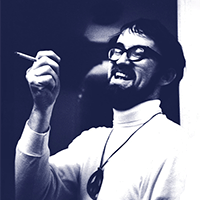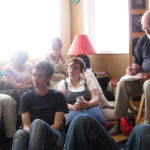3) WHO: Who will be a part of the organization?
“Use any activity to find people like yourself – open-minded, serious, long-term – and bring them into a structure that they can see and learn within. It’s always amazed me how much people want to know and learn about what’s happening to them.” – an email from Dan to Janet Carpenter, a woman he recruited to participate in the Wisconsin recall (2011)
The Labor Education and Research Center, housed at The Evergreen State College from 1987 to 2010, was built to be an organization for working people to see themselves, learn from history, and gain skills to organize.
One thing I learned from Dan Leahy is to start the project and then find the money to do it. The idea and the people are more important; if it’s worth doing the money will come. It took two years to build the Labor Center, and they had to preview it to unions to show them what it would “do.” They packed rooms and made their case for a school for union members to learn political economy, history, and organizing skills. Unions did not have organizing departments, and “that was one role of the Labor Center – to educate and build up rank and file workers based on what was really happening and to organize for power.”
Dan researched Labor Education Centers in other parts of the country and attended conferences at the Seafarers’ Hall in Maryland and in Missoula, Montana. He found that many were labor-management centers, not organizing schools. His research also found that land grant universities had a mandate through the Morrill Land Grant Act of 1862 to provide labor extension programs, similar to agriculture extension.
Support for the proposal was immediate though not from the higher-ups. After one presentation of the labor center proposal to a Central Labor Council, a woman came up to Dan and said “I cannot wait to have this happen.” Dan witnessed the extraordinary strength and potency of union women: “once they’re committed, it’s a done deal.” After Dan’s round of presentations, Central Labor Councils proceeded to pass resolutions in favor of a Labor Center at Evergreen.
The first thing the Labor Center’s hard-working staff of women organizers did was to create a Summer School for Trade Union Women. Dan congratulated the women who made the first summer school happen by raising the funds, recruiting the women, the interns, the coordinator, and challenging working women to convince their unions to spend $225/person for a four-day “summer school” at Evergreen.
“The Summer School that opens today did not just happen. It took a love of history, leadership, self-respect, organizing skills, argument, resources, hard work and belief. It was made possible by women and men who believe working women have always been and will continue to be a critical element in organized labor’s ability to protect and promote the interests of working people.” – from Dan’s opening remarks to 55 trade union women from 18 different unions in 1987 at the first school.
The Summer School for Trade Union Women just sounds like a blast. Based on a historic video about a gathering of working women in 1921, the organizers structured the school into small groups. Day One they learned to form as a group and started working together. They named each group after a historic union woman and had to understand who she was. Day Two they surrounded the groups with education materials and experiences. Day Three, the groups worked together to create a 10-minute video about what they learned, and the Final Day they presented their videos to each other, drank wine, and had a proper graduation with certificates.
Dan talks about the Labor Center, and says “it was the best work of my life.” The New School for Union Organizers were year-long cohorts, and their success exploded in the second and third years. IBEW set up its own organizing department and sent organizers every year. The groups learned skills and had to present a proposed summer organizing project which they then had to execute.
The organizers of the Labor Center Summer Schools and School for Union Organizers created programs and conferences devoted to deepening the leadership of working people. Graduates went back to their unions and demanded to be paid to be organizers with a budget to recruit and train new members – who could then be sent through the Labor Center programs.
Several years in, the Center also organized African-American Leadership conferences, recruiting Aaron Dixon, a Black Panther Party member based in Seattle and Aldon Morris, the author of Origins of the Civil Rights Movement as speakers. Most of the Black union organizers in Washington came through either the New School or one of the conferences.
Mineworker President Cecil Roberts was the “mentor” to one of the Center’s Summer Schools. The School, named “Camp Solidarity,” was inspired by the 1989 Pittston Coal strike camp in SW Virginia. As with the Summer School for Trade Union Women, they loaded everybody up with info. Then they played a “strategy game” based around understanding NAFTA from every perspective. This was modeled after the strategy games Dan learned from the Quakers when he was a tenant organizer in New York.
Dan typed up verbatim the evaluations each participant wrote for every conference. He put them into a single summary document and shared it back to the participants before they left on the last day. Seeing their own words and that their comments were taken seriously was all part of the training.
The participants would study a movement leader who rose from the rank and file. They would have to become familiar with their lives and present them to the whole group. The exercise served two goals – to learn about the power of regular people who became historical figures and to practice speaking and getting your points across. The evaluations and participant reflections show how important that exercise was. An entire Oral History Conference was dedicated to union workers telling stories about strikes and organizing fights as a way to show that their histories were real and mattered.
The Labor Center was constantly under attack – from the school administration, from members of the state legislature, and even from union leadership that saw educating the rank and file as a threat to their power. “I’ve learned to see survival fights for the Center as my professional development opportunity. I pride myself on being a good organizer, a strategic thinker, and an effective mobilizer of people and organizations. Survival fights give me a chance to see if that’s still true, in addition to learning some new techniques.” – from Dan’s 1994 self-evaluation as Director (after an unsuccessful effort to terminate the Center).
Dan’s commitment to the workers themselves, as authentic people with real lives, real struggles, and real potential for greatness is apparent in the carefully crafted curriculum and the many times he had to fight for the Center to continue.
The Labor Center represented a forum for discovering the WHO of the organizing framework. A site, embedded within a university, using the resources of an existing institution (like Lin Dodge taught him) to organize and train working people to find their voices and take action. Dan crafted curriculum from historical fights and built infrastructure that cultivated and connected working people across sectors at a time when labor and working people were under a more global attack.
Return to Framework for Organizing
Continue to FOR WHAT: What is the target?



